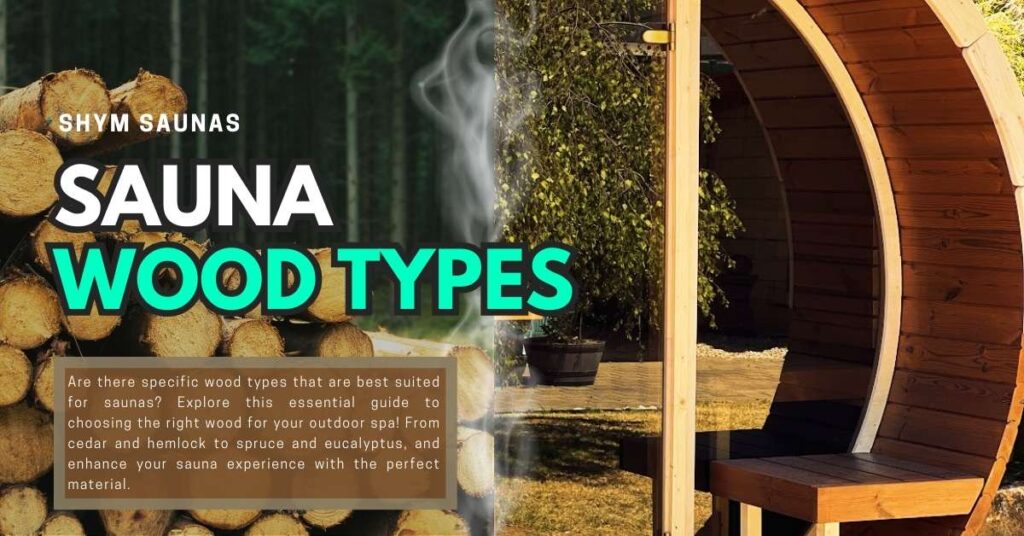Are there specific wood types that are best suited for saunas? Explore this essential guide to choosing the right wood for your outdoor spa! From cedar and hemlock to spruce and eucalyptus, and enhance your sauna experience with the perfect material.
When choosing the perfect sauna experience, the choice of wood is paramount. This article delves into the various types of wood suitable for saunas, their unique properties, and how to select the best option for your needs.
Key Takeaways
- The choice of wood significantly affects the functionality, durability, and overall experience of your sauna.
- Cedar, hemlock, pine, basswood, aspen, eucalyptus, and Nordic spruce are among the most popular choices for building a sauna, each with unique properties.
- Cedar is ideal for those seeking durability and a pleasant aroma.
- Hemlock offers a subtle look and is cost-effective.
- Nordic Spruce is preferred for traditional sauna experiences.
- Scandinavian Thermowood’s durability and environmental friendliness make it a compelling choice
- Aspen and Basswood are great for individuals with health sensitivities.
- Consider aroma, durability, appearance, and cost when selecting sauna wood.
Understanding Sauna Wood Requirements
Sauna wood isn’t just about aesthetics; it serves functional and health purposes. The ideal sauna wood should have:
- Excellent heat resistance,
- Low shrinkage and warping rates,
- Natural resistance to decay and mold, and
- Should not emit harmful substances at high temperatures.
Moreover, certain woods can enhance the sauna experience with their natural aromas and textures, contributing to the therapeutic benefits of sauna use.
What Wood is Used in Finnish Saunas?
In Finland, the heartland of sauna culture, a broader spectrum of suitable woods are used such as Nordic Spruce, Baltic Pine, and even Birch, debunking the myth that cedar is the only option.
Historically, Spruce/Fir has been the go-to option for its affordability and accessibility in Finland. Older saunas often feature spruce/fir paneling, including those with knots for a more rustic appearance, while more contemporary designs lean towards knot-free paneling for a sleeker look.
For benches, the traditional choices of Eurasian Aspen and Alder stand out for their comfort and thermal properties. The trend towards heat-treating bench woods further enhances their durability and user comfort.
12 Popular Sauna Wood Types
Here we dive deeper into the most popular sauna wood types available in the market.
1. Cedar: The Premier Choice

Cedar, particularly Western Red Cedar, stands out for its durability, natural resistance to moisture, and decay, and distinct aromatic scent, enhancing the sauna experience.
Cedar is a top choice for sauna construction. Its insulating properties help maintain consistent temperatures within the sauna. However, cedar can be more expensive than other options.
| Pros: | Cons: |
| – Naturally resistant to rot and decay – Emits a pleasant aroma when heated – Excellent insulator | – More expensive than some other woods – The strong scent may not be preferred by all |
2. Hemlock: Subtle Elegance
Hemlock offers a uniform appearance with minimal knots, making it a favorite for those who prefer a more subtle and refined look.
This wood is favored for its clean, consistent appearance and lack of aroma, making it ideal for those sensitive to strong scents. Hemlock offers good resistance to warping and rotting, although it might not be as durable as cedar.
| Pros: | Cons: |
| – Cost-effective compared to cedar – Resistant to warping and rotting – Little to no scent, suitable for sensitive individuals | – Less durable than cedar – Can be prone to splintering |
3. Nordic Spruce: Traditional Choice
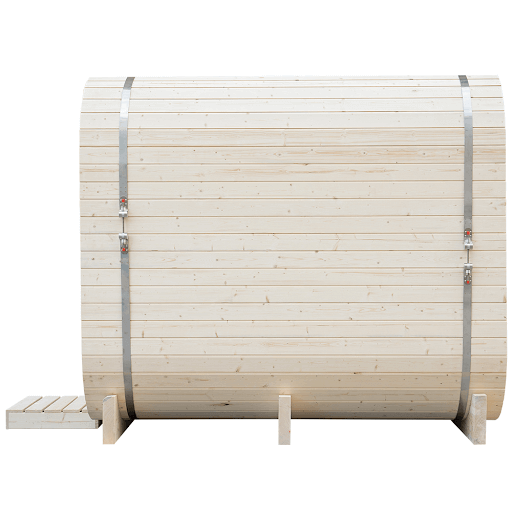
Nordic Spruce is renowned for its high density and durability, making it a popular choice in traditional Finnish saunas.
| Pros: | Cons: |
| – Excellent insulating properties – Contains natural insect-repellent compounds – Light color with a subtle aroma | – May seep small amounts of sap – Might be more expensive due to its high quality |
4. Basswood: Gentle and Soft
Basswood is a hypoallergenic option, perfect for those with sensitive skin or allergies. It has a light color and uniform texture, providing a modern look. While not as durable in humid conditions as some other woods, basswood’s hypoallergenic nature is a significant advantage.
| Pros: | Cons: |
| – Hypoallergenic and smooth to the touch – Good insulating properties | – Not as durable as other woods in humid conditions |
5. Aspen: Hypoallergenic and Modern
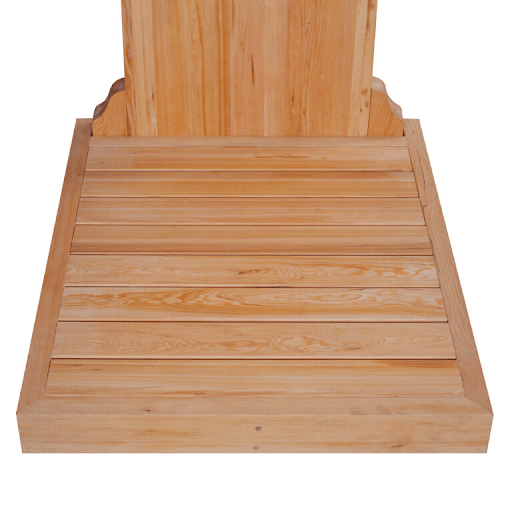
Similar to basswood, aspen is hypoallergenic and features a light, clean appearance. It is comfortable to touch, even at high temperatures, due to its low heat conductivity.
| Pros: | Cons: |
| – Non-toxic, non-allergenic, and resin-free – Resistant to bacteria and fungi | – Less durable compared to denser woods like cedar |
6. Scandinavian Thermowood: Enhanced Durability and Beauty
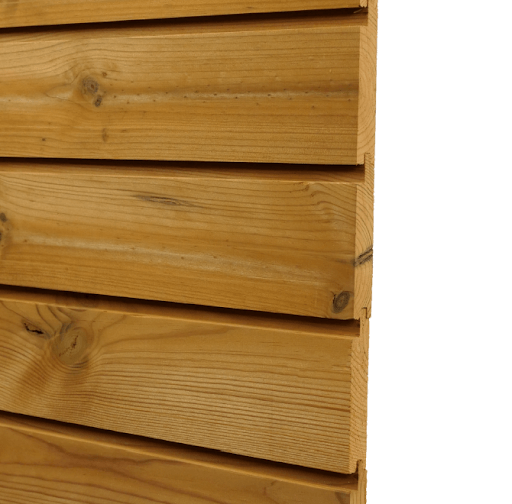
Scandinavian Thermowood is a result of a high-temperature heat treatment process applied to wood, primarily sourced from the sustainable forests of Scandinavia. This process involves heating the wood to temperatures between 180°C and 230°C, while protecting it with steam to prevent drying or cracking.
The heat alters the wood’s chemical and physical properties, enhancing its durability, stability, and resistance to decay and moisture without the use of chemical additives.
| Pros: | Cons: |
| – Greatly enhanced durability and resistance to decay – Reduced moisture absorption, minimizing warping and swelling – Environmentally friendly treatment process without chemicals | – Can be more expensive due to the specialized treatment process |
7. Eucalyptus: Exotic and Durable
Durable and aromatic, eucalyptus is a luxurious choice for saunas. It is strong and resistant to decay, with a pleasing aroma that enhances the sauna experience. Eucalyptus can be more expensive and harder to find.
| Pros: | Cons: |
| – Highly durable and strong – Pleasant aroma enhances the sauna experience | – More expensive and less available than other sauna woods |
8. Pine: Rustic and Affordable
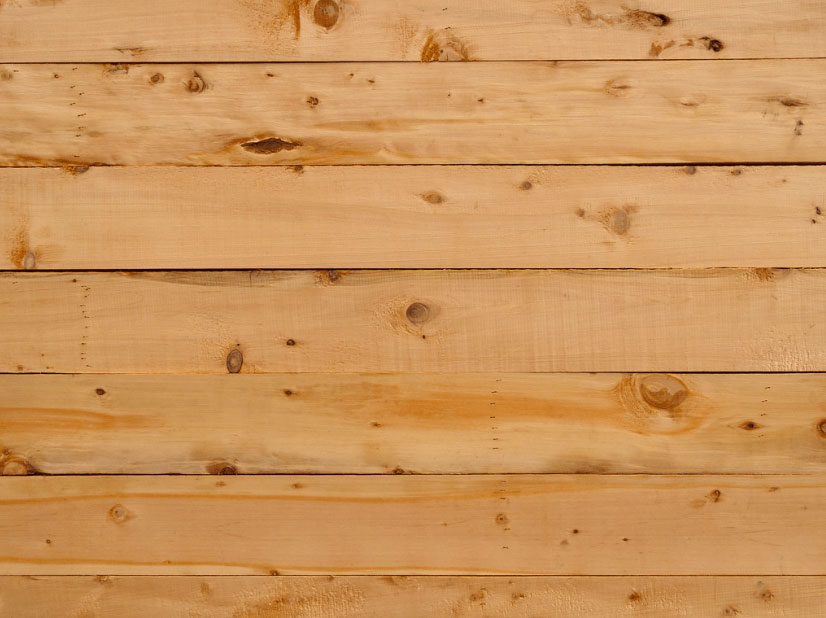
Offering a traditional, rustic look, pine is an affordable option for saunas. It has good insulating properties but is less resistant to moisture and decay. Pine also tends to have knots, which can add character or be seen as imperfections.
| Pros: | Cons: |
| – Cost-effective and widely available – Provides a traditional, rustic aesthetic with its knots and grain – Good insulating properties | – Higher maintenance due to susceptibility to moisture and decay – Knots may lead to uneven surfaces and potential for resin seepage |
9. Douglas Fir: Strong and Aesthetic
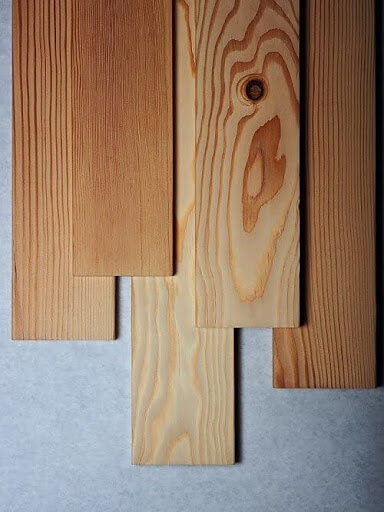
Douglas Fir is known for its strength, making it suitable for the structural components of saunas. It offers a distinctive appearance with a straight grain.
| Pros: | Cons: |
| – Strong and durable, ideal for structural elements – Aesthetic appeal with a light to medium brown color | – Less moisture-resistant compared to other sauna woods – May require more maintenance to prevent moisture damage |
10. Alaskan Yellow Cedar: Unique and Resilient
Alaskan Yellow Cedar is prized for its durability, resistance to decay, and unique yellowish tint, offering a rich look and a subtle smell.
| Pros: | Cons: |
| – Highly resistant to decay and insects – Unique aesthetic with a yellowish tint – Subtle aroma enhances the sauna experience | – Can be more expensive and less readily available than other woods – Similar care considerations as other cedar varieties |
11. Redwood: Distinctively Beautiful
Redwood shares similarities with cedar but stands out for its distinctive red color and resistance to decay, offering a visually striking option.
| Pros: | Cons: |
| – Beautiful red color that provides a unique look – Naturally resistant to decay and insects | – Color may fade over time, turning greyish – May secrete color when new, potentially staining |
12. Poplar: Light and Hypoallergenic
Poplar wood, originating from the Populus genus, is renowned for its lightweight nature, smooth texture, and pale color, offering a clean and modern aesthetic. It’s an increasingly popular choice for sauna interiors, especially for those seeking a hypoallergenic environment. Poplar’s non-toxic and resin-free characteristics make it ideal for users with sensitive skin or allergies.
| Pros: | Cons: |
| – Hypoallergenic, making it suitable for sensitive users – Light color with a smooth texture, offering a modern aesthetic – Resistant to warping and shrinking | – Softer than some other hardwoods, making it potentially less durable – Lacks the natural aroma characteristic of woods like cedar or eucalyptus |
Choosing the Right Wood for Your Sauna: Which is the Best Wood for Building a Sauna?
Cedar and hemlock stand out as premier selections due to their robust qualities, including durability and natural resistance to moisture and decay.
Embracing modern advancements, the use of heat-treated woods such as Thermo Spruce for structural components reflects a forward-thinking approach in sauna design, marrying traditional wood choices with contemporary treatments to enhance longevity and performance.
Selecting the best wood for your sauna depends on your personal preferences, budget, and the specific requirements of your sauna type (traditional vs. infrared).
Consider the following factors when making your decision:
- Aroma: Do you want the wood to contribute a natural scent to your sauna experience?
- Consider Western Red Cedar wood with its distinct, aromatic Finnish wood scent, like the one we use for Barrel Sauna.
- Durability and Resistance: How important are moisture resistance and durability for your sauna’s longevity?
- Environmental Impact: Consider the sustainability and environmental impact of the wood.
- Options like Thermo-treated Nordic Spruce used to construct our Thermo Treated Spruce PATIO S EURO, offer an eco-friendly choice without compromising on durability.
- Appearance: What visual aesthetic are you aiming for in your sauna design?
- Cost: Determine your budget as some woods, like cedar and eucalyptus, are more expensive.
Cheapest Sauna Woods
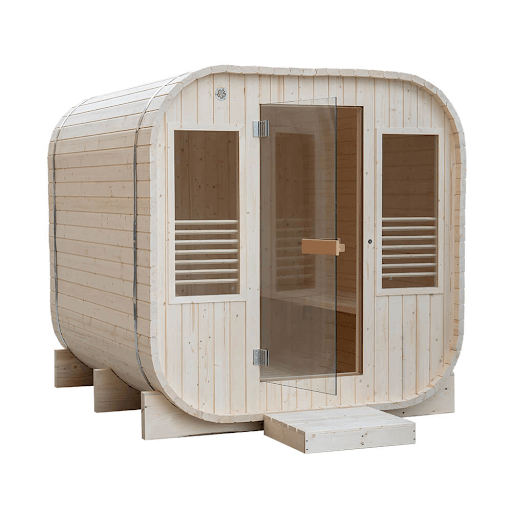
And speaking of cost, you might be wondering which saunas for sale have the lowest cost based on the wood used for construction.
Here’s a look at some of the more affordable choices:
- Eastern White Pine: Widely available in North America, this wood offers a balance of affordability and suitability for sauna use, particularly when selected with care to avoid knots that can cause sap leakage.
- Spruce: Often used in traditional Finnish saunas, spruce is relatively inexpensive and provides a light, airy feel to the sauna interior, though it may require more maintenance than some other options.
- Fir: Similar to pine and spruce in cost and properties, fir is another budget-friendly option, offering a pleasant aesthetic with slightly more resilience to sap issues than pine.
- Aspen and Basswood are more affordable, yet still provide excellent benefits for specific needs, such as hypoallergenic properties.
- Hemlock and Nordic Spruce offer a balance between cost and performance, making them popular choices for budget-conscious individuals.
These woods are popular among sauna builders and buyers looking to minimize costs while still creating a functional and inviting space.
Most Expensive Sauna Woods
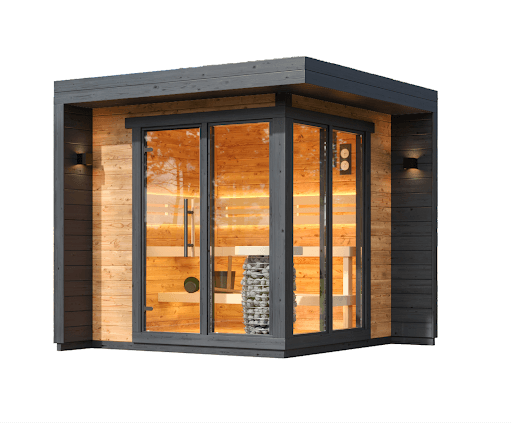
In the upper echelon of sauna woods, certain species stand out for their unparalleled characteristics, making them highly sought after despite their higher price points:
- Western Red Cedar
- Alaskan Yellow Cedar
- Teak
- Canadian Red Cedar
- Eucalyptus
Sauna Interior Wood Types
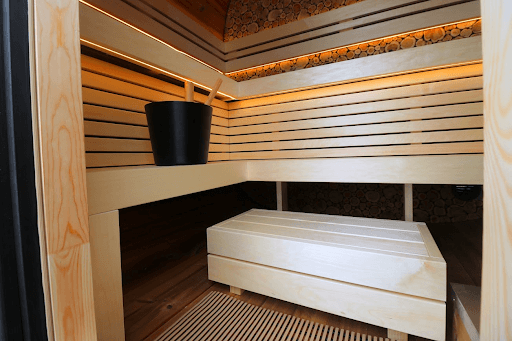
The choice of sauna interior wood plays a significant role in the overall sauna experience.
1. Pine – Heat Resistance and Safety Concerns
Pine, with its accessibility and affordability, emerges as a viable contender. The concerns around its heat resistance, potential toxicity when heated, and the practicality of tongue and groove (T&G) installation for walls, ceilings, floors, and benches are valid.
Yet, it’s reassuring to know that with proper selection and treatment, pine can be a safe and effective material for sauna interiors.
2. Alder, Aspen, Basswood – Best wood options for sauna bench
For seating surfaces, where comfort and minimal heat retention are paramount, Alder and Eurasian Aspen stand out. These woods offer a smooth, cool touch and resilience to the frequent temperature fluctuations within a sauna. Their use reflects a blend of tradition and modern preference, highlighting the evolving nature of sauna construction materials. For hypoallergenic options, wood like basswood is ideal for benches
Regional Considerations for Sauna Wood Selection
For individuals in regions like California and other areas where sourcing exotic woods can present challenges, adopting a cost-effective approach becomes essential.
The suggestion to opt for the most economical wood, avoiding knots in strategic areas like the ceiling and benches, is sound advice.
The use of clear, knotless pine or spruce for the ceiling, combined with regular pine or spruce for walls, and a preference for aspen or alder for benches, embodies a pragmatic approach to sauna construction.
Should I Opt for DIY Sauna Kits Instead?
In some cases, especially for those new to sauna construction or seeking convenience, purchasing a DIY sauna kit may be a more practical solution. Shym Saunas offers comprehensive sauna kits that streamline the building process.
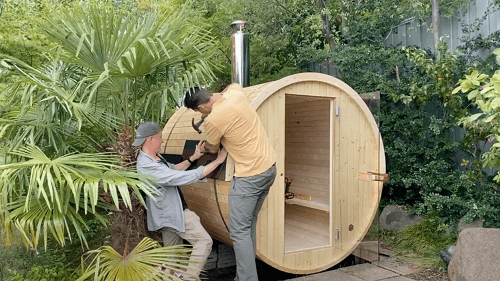
These kits typically include pre-cut wood pieces, that fit seamlessly into your project without the need for sourcing individual materials.
Opting for a DIY sauna kit not only simplifies construction but also ensures that the materials are specifically designed for sauna use, addressing regional wood availability issues while maintaining high standards of quality and durability.
FAQs
Why is cedar often recommended for saunas?
A: Cedar, particularly Western Red Cedar and Canadian Red Cedar, is prized for its natural durability, moisture and decay resistance, and its distinct, pleasant aroma, which enhances the sauna experience. These properties make cedar a top choice for both traditional and infrared saunas, embodying the ideal balance of functional and sensory qualities.
Can I use any wood for my sauna?
A: While many woods can technically be used in a sauna, not all are advisable. Woods chosen for sauna construction must withstand high temperatures and humidity without warping, cracking, or emitting harmful substances. Cedar, hemlock, and heat-treated woods like Thermo Spruce are among the preferred choices due to their resilience and compatibility with sauna environments.
Can you mix wood types in a sauna?
Yes, mixing wood types can optimize your sauna’s functionality and design. For example, using durable wood like cedar for the structure and a softer, hypoallergenic wood like basswood for the benches.
What’s the best way to clean sauna wood?
Regularly sweep or vacuum and wipe surfaces with a damp cloth. Avoid harsh chemicals, which can strip the wood of its natural oils and aroma. For deeper cleaning, use a mild, wood-friendly cleaner.
How do I maintain sauna wood?
A: Maintenance involves gentle cleaning to remove sweat and body oils and occasionally sanding the wood to maintain its smoothness. The Finnish tradition of letting the sauna wood age naturally means accepting and appreciating its evolving appearance, characterized by a soft, faded look that adds character. For woods requiring more care, like pine and fir, preventive steps include selecting knot-free wood and using towels to protect bench surfaces.
What to avoid for sauna wood maintenance
- Chemical Treatments: Products like Thompson’s water seal, tung oil, or teak oil, while well-intentioned for wood protection, are generally discouraged for use in saunas. The high temperatures can lead to the off-gassing of chemicals, and the sealed surface may become uncomfortably hot to the touch.
- Sealed Wood Concerns: Beyond potential health risks from thermal breakdown, sealed wood can alter the sauna’s thermal dynamics, potentially making the wood more heat-conductive and affecting the overall sauna experience.
Is it necessary to treat sauna wood?
Most sauna woods do not require treatment due to their natural resistance to moisture and decay. Treating the wood can sometimes affect its ability to breathe and emit a natural aroma. Light sanding and the application of natural oils can help preserve the wood’s appearance and durability. The Finns believe in embracing the sauna’s evolving beauty, where the wood gracefully ages, taking on a soft, faded appearance that’s rich in character.
How often should sauna wood be replaced?
With proper care, sauna wood can last many years. Regular inspection and maintenance can extend its life and ensure safety and comfort.
Wrapping Up
Choosing the right wood for your sauna is a critical step in ensuring a safe, enjoyable, and long-lasting sauna experience. Consider the characteristics of each wood type and how they align with your sauna goals to make the best choice.
You might want to read:

